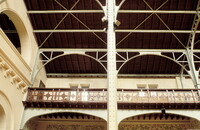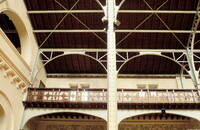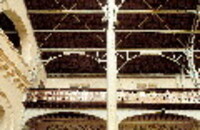| dc.coverage.spatial | Site: Paris, Île-de-France, France | en_US |
| dc.coverage.temporal | 1899-1901 (creation) | en_US |
| dc.creator | Astruc, Jules | en_US |
| dc.date | 1899-1901 | en_US |
| dc.date.accessioned | 2013-02-22T17:59:16Z | |
| dc.date.available | 2013-02-22T17:59:16Z | |
| dc.date.issued | 1899-1901 | en_US |
| dc.identifier | 194309 | en_US |
| dc.identifier.other | archrefid: 1442 | en_US |
| dc.identifier.uri | http://hdl.handle.net/1721.3/101817 | |
| dc.description | Detail of structure over side chapels, northeast corner; Notre-Dame du Travail is built of stone and metal, but unlike them it uses industrial T-section and I-section iron girders, which are riveted and welded together. Its spacious, relatively empty surface at ground level, the openings high up that diffuse an even light throughout the building, and the use of brick and buhrstone make the church seem more closely related to contemporaneous factories than to other Parisian churches built with metal frameworks in various revival styles. The resemblance is intentional as the curate of the parish, Soulange-Bodin, required that the building should reflect, in its structure and materials, the factories in which the parishioners of this working-class suburb worked--hence also the dedication to Notre-Dame du Travail. Source: Grove Art Online; http://www.oxfordartonline.com/ (accessed 7/16/2008) | en_US |
| dc.format.medium | brick; buhrstone; cast iron | en_US |
| dc.rights | © Scott Gilchrist, Archivision, Inc. | en_US |
| dc.subject | architectural exteriors | en_US |
| dc.subject | labor | en_US |
| dc.subject | working classes | en_US |
| dc.subject | Nineteenth century | en_US |
| dc.title | Église Notre Dame du Travail | en_US |
| dc.type | image | en_US |
| dc.rights.access | Licensed for educational and research use by the MIT community only | en_US |
| dc.identifier.vendorcode | 1A2-F-P-NDT-A7 | en_US |
| vra.culturalContext | French | en_US |
| vra.technique | construction (assembling) | en_US |
| vra.worktype | church | en_US |
| dc.contributor.display | Jules Astruc (French architect, 1862-1935) | en_US |



